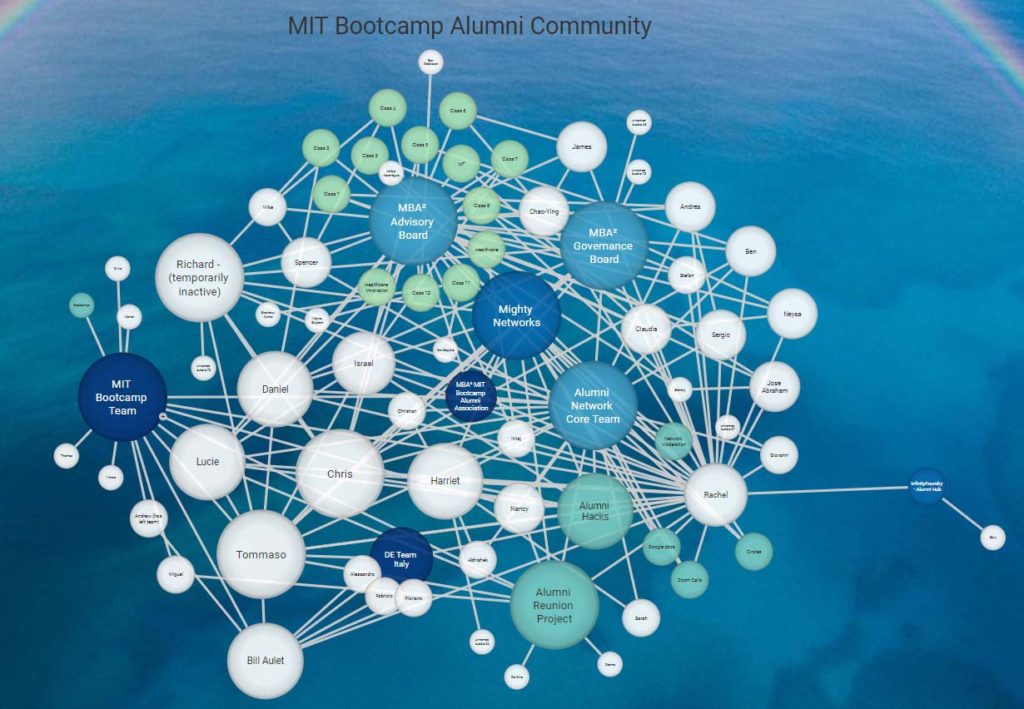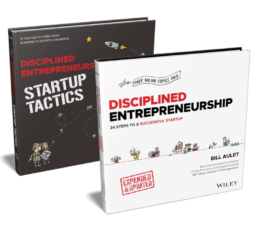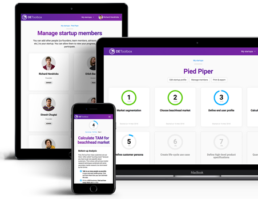
Since 17th April 2018, I am founder and host of the MIT Bootcamp Alumni Association (MBA²), a bespoke and private online network that holds space for the MITx Entrepreneurship Bootcamp Alumni: “An exclusive Mighty Network, built by MIT Bootcamp Alumni, for the MIT Bootcamp Alumni.” Its description reads:
“Our mission is to connect, support, encourage and learn from each other, so that we can each reach our highest potential through continuing to harness the “power of our pack”. We believe this can best be done through co-creation and a stretch-collaboration mindset. #OnwardsTogether!”
Curating the platform entails hours of on-the-side work, mostly late into the night — hours subtracted from sleep. There is no shortage of so-called thankless tasks. And there is no money to be made – at least, not for now. The energy, the joy and the ideas that come from the network are hard to quantify and convey: they are not measurable, they are a tapestry of experiences and feelings (what Nora Bateson calls warm data), perhaps best shared in a narrative. Many people, including fellow Alumni, have often asked me: “Why are you doing this?” and the only authentic answer I can come up with is: “I don’t know, I just feel that this needs to happen, and that I can help it to happen.”
The MBA² Ecosystem — as it is today
Mapping is by definition selective, subjective and reductive, but it has helped me gain clarity on how the MBA² (MIT Bootcamp Alumni Association) is showing up (at this given point in time), how many of us there are in the picture, how we may be relating to one another, and where we may possibly be headed, tomorrow, next year or over the course of the next decade.

As I write, the MBA² network has grown over the last 16 months from a 5-person group (remotely brainstorming together in various online interstitial spaces), to what (in my previous article) I called a “reasonably sustainable model of space-holding”, that currently counts the following tangible elements:
- 610 members — who have voluntarily opted-in through invitation or word-of-mouth;
- 25 discussion circles — member-generated, for conducting topic-focussed group conversations, that range from particular subjects of interest (like Gamification, VC funding or Renewable Energy), to operational clusters (such as the core team, governance and advisory board groups), to place-based chapters (for instance the Brasilian Circle or the Brisbane-Based Bootcampers) to mission-inspired mastermind groups (like the Alumni Hack Circle or the Reunion Planning Group);
- 13 forum-like topics — for sharing news and information that is relevant to the community (see Image 2);
- 55 Alumni-centric events that have taken place (mostly all online) over the last year, at an average pace of one per week.

As I have recently shared in a dialogue on best practices with other community builders from the CMX Hub, one of the challenges posed by our community is the necessary looseness that has hitherto been needed to define and contain the boundaries of the network: because our community has to-date been completely voluntary-based and totally inclusive (it’s an Alumni community, where the only condition to join is to have partaken of one of the paid, in-person, MIT Bootcamp programs — the latter not run by us) the framework has forced us to stay very declaredly open and flexible, conceptually and operationally: in order for the community to survive in terms of entry, participation and engagement, it has had to be an open, welcoming space with no strings attached, therefore characterised by:
- minimum amount of rules;
- pressure to participate kept low;
- anything that gets created is considered a bonus by definition, and welcomed with gratitude and appreciation.
As a network founder and host, the lesson learned over time is to go by the principles of focusing more on what might be the overall, systemic intention of the community — above and beyond any individually limited personal vision of what should (or should not) happen. That’s what — in my work alongside Otto Scharmer and team at the Presencing Institute — we refer to as “what is wanting to be born” and “leading from the emerging future”.
In the next article, we will have a look at how the “24 Steps in 24 Hours” is a poignant illustration of how a project was born out of a shared community intention, struggled to see the light, and was finally brought to successful completion through harnessing collective capacity and energy.
Note: this is the 2nd of 5 articles adapted for the Disciplined Entrepreneurship website, from an original article by Rachel Hentsch, published on Medium.
The author
Rachel Hentsch
Rachel Hentsch is an MIT-Certified Teacher in New Ventures Leadership. She is passionate about strengthening global communities, using tech tools to connect dots. She heads communications at the Presencing Institute and has been researching and prototyping ways to keep global community members connected meaningfully.

The Disciplined Entrepreneurship Toolbox
Stay ahead by using the 24 steps together with your team, mentors, and investors.
The books
This methodology with 24 steps and 15 tactics was created at MIT to help you translate your technology or idea into innovative new products. The books were designed for first-time and repeat entrepreneurs so that they can build great ventures.

How relevant was this article to you?
Click on a star to rate it!
Average rating 5 / 5. Vote count: 2
No votes so far! Be the first to rate this post.
We are sorry that this article was not useful for you!
Let us improve this post!
Tell us how we can improve this post?
